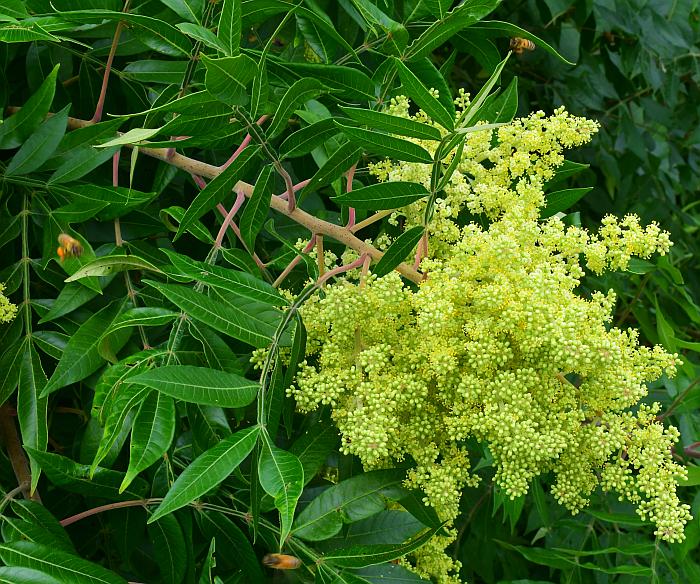Rhus copallinum L.
Winged Sumac

Native
CC = 2
CW = 5
MOC = 60
© SRTurner
Rhus copallinum L.Winged Sumac | |
 |
Native CC = 2 CW = 5 MOC = 60 |
© SRTurner |
|
Family - Anacardiaceae Habit - Shrubs or small trees, rhizomatous, dioecious, sometimes incompletely so. Stems - Ascending, 1.5-6.0 m long, single or multiple, branching. Young branches densely hairy, becoming glabrous or nearly so with age, the older branches woody, with prominent lenticels.
Leaves - Alternate, petiolate, pinnately compound, with 7-13 leaflets. Petioles 3-6 cm long, densely hairy, the rachis narrowly to broadly winged between leaflets (the wing interrupted where the leaflets are attached). Leaflets 3.0-8.5 cm long, 1.5-3.0 cm wide, sessile, broadly lanceolate to oblong, the margins entire or with a few teeth distally, the upper surface dark green, glabrous or nearly so except for the densely hairy main veins, shiny, the undersurface light green to grayish green, sparsely to moderately felty-hairy and with scattered, minute, reddish-brown glandular hairs. Terminal leaflet sometimes divided, abruptly contracted at base and appearing to have a petiolule.
Inflorescence - Terminal, dense, ovoid panicles 12-18 cm long, 6-8 cm wide, the axis and branches tomentose.
Flowers - Sepals 5, basally fused, 0.8-1.1 mm long, ovate, bluntly to sharply pointed at the tip, moderately to densely hairy. Petals 5, 1.5-2.5 mm long, oblong, rounded at the tip, yellowish green. Stamens 5, erect, exserted, alternating with petals, the filaments white, to 1.5 mm long, the anthers ovoid, yellow-orange, 1 mm long. Styles 3. Ovary globose, tomentose to puberulent, 0.9 mm in diameter, unilocular.
Fruits - Drupes 4-6 mm long, 4-5 mm wide, somewhat flattened, red, with dense, minute, stout, red glandular hairs and sparse to moderate, longer, white to colorless nonglandular hairs, the outer layer and resinous fleshy to waxy middle layer readily detachable from the smooth stone.
Flowering - May - November. Habitat - Glades, upland prairies, degraded prairies, savannas, mesic to dry forest openings, old fields, railroads, roadsides, open, disturbed areas. Origin - Native to the U.S. Other info. - This species occurs throughout Missouri except for the far northern counties of the state. Missouri lies near the westernmost extent of the plant's range, which extends southward and eastward to the respective coasts. It is easily recognized by its shrubby habit, odd-pinnate leaves, and the winging found along the leaf rachis. This winging can vary from narrow to fairly broad. The leaves turn a brilliant crimson red in the fall. The species can also be recognized during the winter by its fruit clusters, which are unique in the genus in that they droop downward in old plants. Photographs taken at Dave Rock Conservation Area, St. Clair County, MO., 7-27-00, at Logan Creek, Reynolds County, MO, 7-3-04 (DETenaglia); also at Crowley's Ridge Conservation Area, Stoddard County, MO, 7-17-2009, Hughes Mountain Natural Area, Washington County, MO, 10-29-2018, Meramec Conservation Area, Franklin County, MO, 7-14-2020, Taum Sauk State Park, Iron County, MO, 8-04-2020, Shaw Nature Reserve, Franklin County, MO, 7-10-2021, and St. Joe State Park, St. Francois County, MO, 7-11-2025 (SRTurner). |